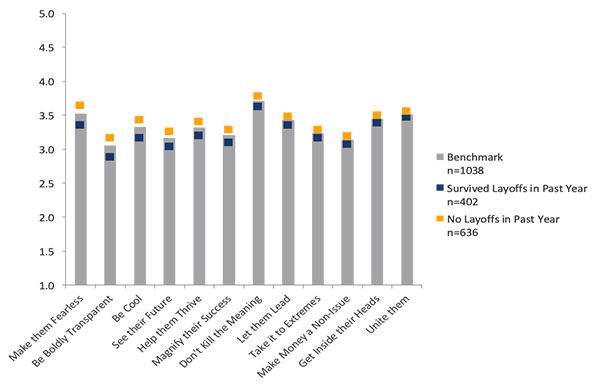How to lead after layoffs
Written by: Amy Stern, Managing Director, Research and Strategy, BI WORLDWIDE
(View Author Bio)
After making the difficult decision to reduce their workforce, research shows organizations must consider how to support those leaving and employees who remain.
Scroll Down
There are uncertainties in business. We plan, innovate and conserve, but there are still times when that is not enough. As difficult as they may be, workforce reductions are sometimes the only way to preserve the business, and more importantly, to preserve the jobs of even more people. When reductions happen, many companies do as much as they possibly can for exiting employees, often including severance packages or outplacement services. But what about those employees whose jobs are still intact? Is there anything we need to do differently to support them?
Our research shows those employees who work for companies that experienced workforce reductions in the previous year are less happy at work, less committed to the company, and perform with less intensity. Although they are likely grateful to have kept their jobs, their experience at work has no doubt changed.
Specifically, those who were not part of a layoff or furlough are actually more fearful than those who work for companies that did not experience workforce reductions at all. They also feel more in the dark on company decisions, find their companies less exciting, are more concerned about their future, are more overworked, feel less recognized and find their purpose less clear. This research provides strong evidence that organizations who must make the difficult decision to reduce their workforces should carefully consider how to best support those who must leave and those who get to stay.

After planning for how to support departing employees, companies should ask themselves what they can do for their remaining workforce. Consider how to:
- Instill a sense of confidence in leadership. Authentic communication from leadership can be in the form of cell phone videos, e-mail, or virtual or in-person town halls. While leaders do not need to share everything with everyone, employees will often assume the worst in the absence of information. If you truly don’t know an answer, tell them that - but also tell them what you are doing to figure it out. Give employees an opportunity to provide suggestions and help solve those problems.
- Reassure employees of their job security without overpromising. Explain why furlough or layoff decisions were made and how they impact the budget. Outline how the decision will make the odds of them keeping their jobs stronger, not weaker.
- Create a culture of inclusion and belonging. The value of “be cool” in the chart above really means “be inspiring and create belonging.” Employees will want to know that you are still innovating and doing exciting things – and that they are a part of it. Share these good news stories as well as the vision for the foreseeable future of the business.
- Develop the careers of your employees. In a time of great uncertainty, it may be tempting to put career pathing on hold. However, employees are more likely to stay and work hard for an organization at which they believe they have a bright future. Encourage managers to continue having career conversations. Managers can note these needs and tell employees how they can grow now to meet these goals.
- Ensure appropriate staffing to avoid burnout. The reality is that in the midst of furloughs or layoffs, many organizations will be understaffed for some time. Identify where these gaps are and create a plan to backfill those positions first. Tell employees when you expect that to happen and ask how you can support them in the meantime.
- Recognize employees for their excellent contributions. Acknowledge the difficult time, the employees’ extra effort and investment and show genuine appreciation for it. These authentic messages should be delivered from managers as well as higher levels of leadership.
- Bring the focus of work back to the reason for doing business. Messages from leadership can focus on why you do this work as well as anything you may be doing to help others. When you talk about your good news and vision, mention your mission. When you recognize, recognize those who are living out this mission or your company’s values.
Workforce reductions of any kind are never taken lightly. The pain is real for both employer and employee and there are many resources available to help departing employees through the transition.
However, in the midst of caring for those departing employees, attention often gets detracted from the employees who remain. Those are the employees we are going to rely on to come out of this difficult time – to be creative, to innovate and to endure and sustain us for the future. Ultimately, it was saving these jobs that led to the difficult decision to reduce the workforce so we should do everything we can to protect them.













